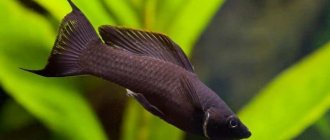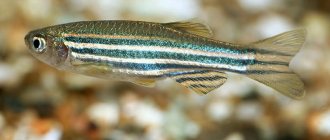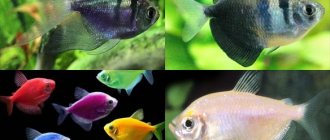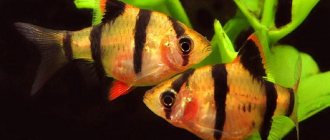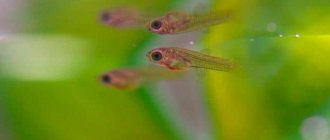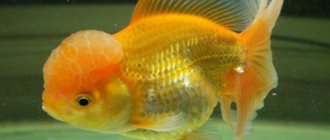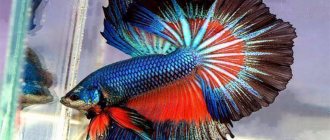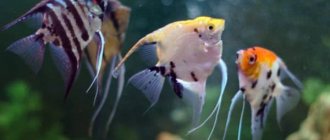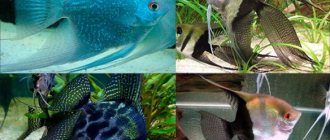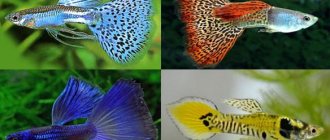Size
The most obvious sign is the size and shape of the abdomen. In females it is always a little larger, since in the future they will have to bear eggs.
It is important that the Danio’s tummy can stretch for other reasons: for example, in the case of a disease of the digestive system. Males can also suffer from such diseases, so you need to pay attention to the very shape of the abdomen. In “girls” the abdomen is evenly curved, while with the disease the anterior part of the body is significantly prominent.
Male above, female below.
Color
Another sign thanks to which you can easily distinguish males. “Boys”, as a rule, are colored more brightly and attractively, since they should attract the attention of “girls”.
Females, in turn, have a duller and more uniform color. Under natural conditions, pregnant females often hide from predators, so their faded coloring serves as their natural camouflage.
The photo shows that the veiled male Danio has a brighter color (the fish is below), unlike the female.
Behavior
In addition to their bright colors, males stand out for their character. “Boys” behave more active and mobile than “girls” - this is especially noticeable during the spawning period. Some individuals, as a rule, chase others or cut circles around them. It’s easy to guess that the male is the active partner, and the “victim” is the female.
Anal fin
Interestingly, male and female Danios differ in their anal fins. In females, this fin is larger and its edges are rounded. In “boys” the fin is pointed and its length is shorter than in females.
Unlike previous methods of sex determination, this sign is not as pronounced, so novice aquarists should not rely on it.
In the photo below, upon closer examination, you can see the difference in the anal fin of a female and a male; in an aquarium, when the fish are actively moving, it is very difficult to see this difference.
On the left is a male with a small anal fin and sharp edges, on the right is a female with a larger fin and rounded edges.
Experimental method
If you have doubts about your abilities and are not confident that you will be able to correctly determine the sex of all the fish, then you can conduct a simple experiment. Its essence lies in the fact that it is necessary to create conditions for Danio under which they prepare for spawning - thereby sexual dimorphism becomes more pronounced.
In nature, these tropical fish breed during the rainy season, when more small creatures appear in reservoirs and the water becomes warmer. Thus, to conduct the experiment, you just need to increase the water temperature (up to 24-25 °C) and feed the fish generously with live food .
After a few days, the females’ belly will noticeably increase in size, and the males will acquire an even brighter color and will move much more actively.
Other signs
Another sign can be considered the difference in the size of the fish’s bodies themselves. "Girls", as a rule, are somewhat larger and longer than "boys". This feature is explained by the need to bear eggs, which requires more physical effort and energy expenditure.
Example on Glofish fish, the female (right) is about 30% larger than the male. Same age.
Description of zebrafish, the difference between males and females
Danio rerio is a small fish - 4-5 cm, with an elongated body. The color is silver, with blue (black) stripes. The fins are veil-shaped, as a rule, the edges of the fins are colored orange. The female is distinguished from the male by her thicker abdomen; as a rule, she herself is also larger. The female is also paler in color. Also, in some species of zebrafish, females have two longitudinal stripes on the body, while males have four. If you look at the abdomen, in males it is usually golden in color, in females it is closer to orange.
What to look for?
So, let's talk about how to distinguish a female from a male in zebrafish. Let us immediately note the fact that sexual dimorphism in zebrafish is not very developed. Fish of different sexes are very similar to each other, but certain different features still exist.
Let’s look at the main “insignia” and, for convenience, draw up something like instructions.
Dimensions and dimensions
The most important criterion for sexual differences in zebrafish should be considered dimensions. Females are always somewhat denser than males in the abdominal area, and in general they look larger. Males, on the contrary, have a leaner, arrow-shaped body and are half a centimeter shorter than females in length.
These differences have a natural explanation. Females are destined by nature to carry eggs, so their abdomen must be able to stretch and be large enough to contain fry.
Here it should also be said about the importance of comparing exclusively adult individuals. The fact is that young zebrafish have practically no external sexual differences, and only a specialist can find out who is male and who is female.
Therefore, when purchasing, it is better to be guided by the rule of purchasing a school of zebrafish of approximately the same age, and it is better to take only adult fish. After all, young fish have not yet fully formed and continue to develop, including externally. Especially if the prospect of breeding them is important to you. After all, a young female two months old, for example, is practically no different from an adult male. She is as slender and flattened on the sides as a male.
Color
The next external sign of difference between individuals of different sexes is the brightness of color. Males tend to have more striking colors. Their stripes are more pronounced than those of the female, and the intensity of their tint is noticeably higher.
Females tend to be less noticeable due to the natural need for camouflage during spawning. After all, a pregnant female is much slower in movement than a nimble male or a young nimble individual not burdened with eggs.
And its more monotonous color serves as good protection, allowing the fish to blend in among the thick algae in muddy water. Males, on the contrary, are distinguished by their bright scaly plumage.
The brighter the male, the more attractive he is to females, and the higher his chance of passing on his gene to the next generation of fish.
Character
The behavioral differences between male and female zebrafish should not be overlooked. Males are much more active and faster than females. They tend to actively fuss around their “chosen one,” especially during the breeding season.
At the same time, males tend to chase females not only for reproductive reasons. In this way, the hierarchical system within the school is maintained, and the pursuit of a male by a female may not at all mean that the fish are ready to reproduce.
Other signs
100% way to figure out sex in zebrafish.
In males, this fin is shorter and pointed. This difference cannot always be clearly distinguished; this is rather a point for specialists, so we do not focus on it, but we also do not forget.
You can reveal who she is and who he is in this experimental way. These fish tend to spawn during periods of heavy rainfall, when reservoirs fill with water and become warmer.
You should simulate such conditions for your pets by raising the temperature in the aquarium to 24 degrees. It is best to place the fish in different containers at this time, and feed them well with live food at the specified temperature. Within a few days, a thickening of the abdomen in the area of the anal fin will be noticeable in females.
Males tend to become brighter in color, and during the period of readiness for reproduction they are unusually active and begin to increasingly sort things out among themselves.
Contents Danish Rerio
Mobile fish are usually kept in schools of 8-10 fish. They are very playful, so they can jump out of the aquarium. We must take precautions. If you have zebrafish in your aquarium, do not forget about the lid on top. Zebrafish live in the upper and middle layers of water. Aquariums of almost any size are suitable for zebrafish, but it is still better to keep them in aquariums where they can swim freely. The optimal acidity of water is 6-7.5 units, hardness practically does not matter, the water temperature is 24 degrees Celsius, although zebrafish can easily tolerate higher and lower temperatures. Perfectly compatible with algae floating on the surface of the aquarium. A weekly change of 10% of the aquarium water volume is required. It is preferable to use live food - cyclops, daphnia, bloodworms. But in certain cases, dry food can also be used. Although the fish are peaceful, when feeding they can snatch food almost from the mouths of their slower counterparts.
Kinds
Zebrafish are amazing in their diversity. Wikipedia lists about 10 species of these aquarium inhabitants, which differ in color and size. Let's look at the most popular of them.
Danio rerio
Photo of zebrafish
The most common fish among aquarists is the zebrafish (Danio rerio). Because of their original striped coloring, they were nicknamed zebras or lady's stockings. Along the light yellow body of this fish there are longitudinal blue stripes. Such original coloring serves as natural camouflage, which is so important in natural conditions. Stripes run along the caudal and anal fins.
They live in the wild in southern Asia.
The maximum length of the creature is 6 cm.
Representatives of this species are rightly considered the most unpretentious and hardy among its relatives.
Danio pearl
School of pearl zebrafish photo
Pearl zebrafish (Danio albolineatus) is a schooling fish. The body at the back is bluish in color, the front part has almost no color. There is an orange stripe along the middle line. Under special lighting, the fish develops a characteristic pearlescent tint, which gave rise to the name of the species.
Fish of this species are unpretentious and practically do not get sick, like all representatives of the genus in question.
Danio pink
A school of pink zebrafish
The pink zebrafish ( Brachydanio albolineatus ) has an original coral color. White stripes run along the body, and the same stripes are present on the colorless fins. The fish was bred artificially and is not so colorful in natural conditions.
Danio yellow
Close-up photo of a yellow zebrafish
The yellow zebrafish (Brachydanio rerio) has a golden color. Its intensity depends on the size of the flock. There are narrow stripes on the sides that go into the caudal fin. Other fins are yellowish or colorless.
No special principles for keeping fish of this species have been noted; they are relatively resistant to diseases.
Danio malabar
Malabar zebrafish against the background of plants in an aquarium
Malabar zebrafish (Devario aequipinnatus, formerly Danio aequipinnatus) is the largest zebrafish. In natural conditions it can reach 15 cm in length; aquarium specimens grow up to 10 cm. Representatives of the species are distinguished by their original appearance. Three or four stripes of blue or blue-green color are located behind the head of the body, and behind the gills there are several strokes of golden color. One wide stripe penetrates the entire body and passes into the caudal fin. In males it is located in the middle, in females it reaches the upper part of the tail.
They are as easy to maintain as many of their relatives.
Danio Golden Ring
Photo of the Golden Ring Danio near
the Golden Ring Danio (Danio tinwini) - the only zebrafish that swim throughout the entire water column. Gold rings and black spots are randomly placed on the golden surface of the body. The belly is silvery, the fins are transparent with dark spots.
They are unpretentious in maintenance and care, like all their relatives.
Danio glofish
Photo of colorful zebrafish Glofish Zebrafish
Glofish is the newest species of zebrafish, which was bred as a result of genetic modification of the zebrafish species at the beginning of the 21st century. The bioluminescence gene is included in the genetic code of this fish. Representatives of the species have an unusually intense color.
From its relatives, the glofish zebrafish inherited its unpretentiousness to living conditions. They prefer a higher temperature of the aquatic environment - it is increased to 28 degrees.
Content and Compatibility
Zebrafish can be classified as a fish with good health and the ability to survive in almost any conditions. They can also be kept in a three-liter jar if you can’t afford to buy an aquarium. However, know that in such conditions you will not be able to fully enjoy the beauty and playfulness of these fish.
If you want to create comfortable conditions for them or are planning reproduction, then you should look for an oblong-shaped aquarium of 50 liters or more. But zebrafish look best in aquariums with a volume of 100 liters or more.
Be sure to cover the aquarium, since these fish are very jumpy and often end up on the floor if they frolic too much in the water. You can lay fine gravel at the bottom and plant any plants. It is only necessary to leave a well-lit free area where the zebrafish could quickly swim and play.
The following parameters are considered optimal for maintenance:
- temperature 20-25°C in the warm season and 17-21°C in the cold season;
- water hardness (dH) - 5-15°. But it’s best not more than 10°;
- acidity (pH) - 6.0 -7.5.
In order for the fish to feel good, it is necessary to regularly change the water. Within a week or two it should be about 25% of the total volume.
It’s good when the replacement water is 1-2 degrees higher than that in the aquarium. It is highly advisable to install filtration and aeration.
These fish are not picky about food, although it is advisable to use live food more often than dry food. Bloodworms, small daphnia or coretra are best suited for them. With them, however, as with other fish, it is better to adhere to the rule: it is better to underfeed than to overfeed.
It is advisable to give them small portions several times a day rather than one large portion. The fish may not be able to cope with such a volume, and the water from the leftover food will begin to quickly deteriorate, which can lead to illness in the fish and even their death. If you feed once, then you need to do it in the morning.
Zebrafish are not very conflict-prone and can get along with almost any neighbor. They will do well in an aquarium with neons, swordtails, gouramis and laliuses. However, it is not recommended to house them together with veil forms, as they can spoil their appearance. And they certainly don’t belong next to aggressive fish. But they will like the proximity of shrimp and snails. If you are interested in reproduction and selection, then for the spawning period they will have to be placed in a separate aquarium.
Nuances you need to know
It would seem that the given characteristics are quite sufficient to unambiguously establish the sex of a particular individual. In reality, these differences are quite difficult to notice, especially for inexperienced aquarists. The situation is further complicated by the fact that Danios are very mobile fish, so examining them is very problematic . In addition, certain nuances should be taken into account:
Beginners are recommended to purchase several Danios so that they immediately form a school, and it is better to buy adult fish. If you plan to breed them, it is important to initially understand the sexual composition of the flock
How to distinguish depending on the species?
Some varieties of zebrafish have their own distinctive characteristics, but they all boil down to different colors or sizes of “girls” and boys:
Do not forget that all species are characterized by differences in behavior: males are always more active than females.
Zebrafish breeding
Zebrafish reach sexual maturity at 5-6 months. Breeding aquarium zebrafish begins as it should with preparation. First of all, the best period for fish breeding is the spring, when live zooplankton (daphnia, cyclops, etc.) appears in abundance. You can restrain the fish before spawning by lowering the water temperature. If you are ready for your aquarium fish to start spawning, the first thing you need to do is prepare your spawning tank. The desired volume is at least 20 liters for 2 fish. Place plants with a root system (can be in a pot) and floating ones in it. The female will begin to spawn on the plants. Alternatively, plants can be offered dark fabric suspended from a floating feeder or branches on the bottom. The water in it has physical and chemical properties similar to the water in the main aquarium. (see paragraph above) The water in the main aquarium rises to 25-26 degrees. The females begin to bear eggs. As a rule, 1 female and two males are used for spawning. A week before spawning, the female separates from the males and feeds heavily on daphnia and bloodworms. The main aquarium may not be conducive to spawning; the female may restrain spawning in search of a quieter place, but for known reasons does not find it. The female and male are transferred to the spawning area in the evening. Perhaps the next morning the spawning will begin. The male will begin to chase the female around the spawning aquarium, and she, in turn, will release eggs. The male will fertilize her. As a result, the female will release from 80 to 300 eggs. The agility of the fish at the end of spawning will drop noticeably. The fish must be removed immediately and the eggs must now be observed. Whitened (dead) eggs must be removed from the aquarium. If there are a lot of whitened eggs, then perhaps the water quality does not meet the required level, but it is too late to change anything. It is also possible to have weak producers, in which case the fish must either be fed or replaced. As a preventive measure, some measures are used: 5-8 days before spawning, they keep some silver object in the spawning area - a spoon, a large coin, etc. to obtain “silver” water. If this is not done, then as soon as the spawners are planted, the spawning ground water is disinfected or treated differently: the simplest thing is to replace 75 percent of the water with freshly settled water, the same temperature or a little more by 23 degrees. Water can be disinfected with a two percent iodine solution - 2-3 drops per 10 liters (the water is stirred carefully and thoroughly) or penicillin - 2500 units per liter of water. Penicillin is pre-dissolved in a glass of water at room temperature and applied as evenly as possible to the spawning area. The release of larvae from eggs depends on the water temperature in the spawning aquarium, so at 26-28° degrees, the offspring appear after 30-36 hours. If, for example, the temperature is 17°, then the emergence of the larvae is delayed for a week or more. After the larvae appear, they simply hang on their “tails” attached to the place where the eggs were. Further, on days 5-6, the larvae begin to swim,
3-4 day old zebrafish fry - rerio
... it is from this moment that they are called fry. After two to three weeks, the fry grow so much that it becomes necessary to transplant them into a more spacious, pre-prepared aquarium.
If we talk about the peculiarities of fish reproduction, we can say that the female spawns again after 7-10 days. Moreover, if the conditions are not created for the female, that is, she is not placed for spawning, then she may lose the ability to reproduce completely. It is also important to note that the fish are spawning if you are going to raise fry. If you do not have such a need, then the fish can spawn in the main aquarium, but in this case the fry and eggs will most likely be eaten by everyone.
Interesting Facts
- Unpretentious in care and maintenance, zebrafish (the most typical representative of this genus) are widely used to study the development cycles of vertebrates. These creatures were first proposed as model organisms by George Streisinger
- A significant advantage of zebrafish is its rapid development cycle: the embryo turns into a larva within three days. Their embryos are large and transparent, their development occurs outside the mother’s body - and this greatly facilitates the work with biological material.
Possible breeding problems
Beginning aquarists very often encounter the fact that such unpretentious zebrafish refuse to spawn or the eggs turn out to be non-viable. Most often this is caused by improper fish keeping. For example, if the fish were kept for a long time in conditions of elevated temperature and intensive feeding. To avoid this, future breeders are kept at 17-18°C with scanty feeding, and only in preparation for spawning do they increase the water temperature and increase the amount of food.
If a pregnant female is still unable to disperse, then it is necessary to help her.
Also, during the spawning process, it happens that the released female simply avoids the advances of males, hiding from them in aquatic vegetation. The main reason for this lies in unripe or, on the contrary, overripe caviar. In this case, the female and males are left in the spawning area for another day. If the spawning process still has not begun, and the female’s abdomen looks small, then she is placed in a separate container for several days and fed intensively. Usually during this time the caviar matures.
When the eggs become overripe, the female also refuses to spawn. In this case, she needs help to free herself from it. To do this, gently squeeze it between the thumb and forefinger of the left hand, and carefully squeeze the caviar out of it with the finger of the right hand. If removed correctly, after 5-7 days the female is again ready for spawning.
Why is this so important?
So, determining the sex of Danio is difficult, but still possible. First of all, awareness of sex differences is necessary for fish breeding. It is logical that it is difficult to get offspring if the flock consists of 5 males or 5 females.
In addition to this, it is important to ensure a quantitative advantage for the “boys” - only in this case will the Danios reproduce successfully. Finally, do not forget that Danios are schooling fish that cannot exist alone. Within each flock, a clear hierarchy is formed, which depends specifically on the number of females and males.
Source
How to feed
But pink zebrafish have an excellent appetite precisely because of their agility. They happily eat any common types of food:
- bloodworm,
- daphnia,
- small insects and their larvae,
- small plant seeds,
- frozen moina,
- as well as ready-made branded feed TetraMin.
True, you should not abuse commercial feed.
Fish are good at picking up food from the surface of the water, in its middle part, but they will never take food from the bottom.
Diseases
Even strong fish like zebrafish can get sick, but in good conditions and with quality care this happens less often.
Plistophorosis
The onset of the disease can be noticed by the presence of white spots on the surface of the body, which then turn into ulcers. The fish begin to swim at an angle and lose weight.
To get rid of the problem, it is worth disinfecting the reservoir and replacing the soil. The most effective disinfectants are bleach and hydrochloric acid solution (5%). While the tank is being cleaned, the fish should be transplanted into another aquarium and given medication.
The following drugs are used to treat plystophorosis:
- trichopolum (per 1 liter 5 mg);
- erythrocycline (per 1 liter 50 mg);
- methylene blue (per 1 liter 10 mg).
Fortified food supplements are also used for treatment.
Trichodinosis
The symptom of the disease is a gray coating that covers the entire body of the zebrafish. The source of trichodinosis are ciliates. Fish become infected upon contact with plants or other contaminated objects in a pond.
To solve this problem, it is enough to increase aeration, raise the temperature to +31 C, and add regular table salt at the rate of one tablespoon per 10 liters. The fish's body can recover from one to four weeks. All this time it is necessary to maintain the concentration of salt in the water. After complete recovery, the water must be changed in parts so that the salt concentration decreases gradually.
Caring for fry
For several days after hatching, the larvae sit motionless on everything in the aquarium. During this time, they feed from the yolk sac. After five or six days it resolves and the fish are forced to start moving in search of food. From this moment on, they already turn into fry.
What to feed the fry in the first days?
At first, the fry are fed with liquid food, which is sold in pet stores. It is necessary to feed babies first with ciliates, periodically adding ready-made food - this can be plankton and small crustaceans. The fry grow very quickly. Once they reach a length of about 1.5 cm, you can move them to a community aquarium. After about six weeks they will grow to 2.4 cm.
Feeding the mudskipper
Mudskippers are not picky eaters at all and, in most cases, will eat any food that the owner offers. The natural diet of mudskippers is very diverse: they eat insects, grabbing them on the fly, mollusks, crustaceans along with shells, and worms. They don’t disdain algae either.
When keeping at home, it is best to diversify the fish’s diet as much as possible. For dry food, small floating granules that mudskippers can swallow right away, such as Tetra Cichlid Algae Mini, work well.
You can feed the fish with pieces of shrimp and minced fish. Live crickets are eaten with pleasure. It is best to feed fish on land, as in water they become short-sighted. Mudskippers very quickly get used to feeding time and within a couple of days they line up for the next portion of food. They are easy to train to eat from your hands.
Bug-eyed
This disease is typical for adult fish. It happens during spawning. The body does not change its color, but at the same time the abdomen increases significantly, which at first glance seems natural during spawning. But then, within fifteen days, the fish's eyes protrude from their sockets and then fall out. The blind fish dies from exhaustion. Upon autopsy, a white thick mass is discovered behind the eyeball, which causes bulging eyes. Poor quality water is the cause of this disease. Treatment: water change (partial) - every 2 days.
If spawning fails
Fish refuse to reproduce for various reasons:
- Infertility. Not everyone can bear offspring due to genetic predisposition or injury. Find other zebrafish to breed with.
- Bad time for spawning. The fish may not show interest in each other, since this process is not mechanical. Be patient and repeat the steps necessary for breeding.
- Immaturity. Your fish may not be mature enough to breed yet.
- Inconsistency of water parameters. Check if all conditions are met.
